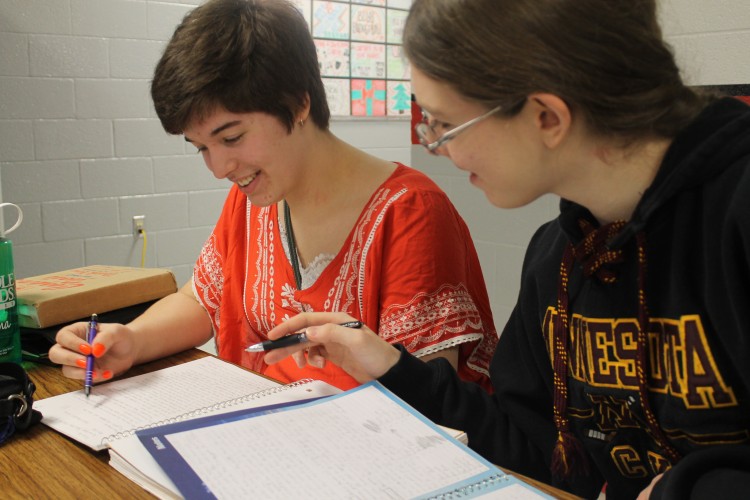With the goal of writing a 50,000 word novel within 30 days, writers around the country participated in National Novel Writing Month (NaNoWriMo). Among those aspiring writers are four Benilde-St. Margaret’s students––Megan Larson, Kiley Petersen, Glenna Greer, and Colleen Vollbrecht––who set their own unique goals during November in hopes of developing a storyline and improving their writing skills.
During NaNoWriMo, writers could set their own targets. Instead of the standard goal of 50,000 words in a month, senior participant Larson raised her goal to 100,000 words. “The standard goal is 1,666 words per day, and it comes out to around 3,000 words per night for me,” Larson said.
Senior participant Petersen decided to take a different approach to NaNoWriMo. Instead of aiming for 50,000 words, she set her own goal of 10,000 words. She reduced the target word count because her novel, which includes a fictional woman in the Manhattan Project, is based on accurate accounts. “I enjoy writing about this topic because very few people know that women had an important role in the Manhattan Project,” Petersen said.
Although many NaNoWriMo writers have a passion for their work, few can last the month without hitting obstacles. Writers have given the nickname “The Two Week Slump” to the writer’s block that many experience in the second week of November. To overcome this, the NaNoWriMo website offers the game “Write or Die,” where if one stops writing for too long, the program will start deleting letters to force the writer to continue typing. Other writers solve the problem by skipping parts of their novel, saving less eventful parts to be written later. “I have the outline to my story, but I sometimes have trouble writing certain parts as descriptions and dialogue,” senior participant Vollbrecht said.
Many students participate in NaNoWriMo because of the flexibility and creativity it offers writers. The event’s website, nanowrimo.org, features forums in which writers can exchange essays, ask for plot ideas, and participate in writing events. “Users swap novels at the end of November to critique and edit the other’s work of the same genre,” Larson said.
NaNoWriMo also provides support groups that new writers can use to stay dedicated to their writing. Once writers exceed their word count goal, they copy and paste their work into a word validator and then receive a congratulatory PDF certificate. “My online support group simply would not have let me quit, even if I wanted to. Many people are also surprised when they learn that we just get a certificate,” Larson said.
However, for many writers the certificate is not the main goal. Most writers use NaNoWriMo to get ideas down in writing, where they can be edited later. In fact, many writers then feel the obligation to perfect their work after reaching the November 50,000 word goal. “Often I randomly start doodling characters and make a plot out of them. NaNoWriMo gets these ideas onto paper, which I believe is the hardest part of writing,” Vollbrecht said.
While the goal of many writers participating in NaNoWriMo is to improve their writing skills, the main ambition for many is to simply get words out on the page, not worrying about grammar until after the month is over. “NaNoWriMo actually suggests that we should not focus on being grammatically correct; you’ll be in pain if you do,” Vollbrecht said.
In fact, many writers plan to continue their novels after November. Larson, who participated in NaNoWriMo last year as well, continued writing a modern fiction story, and since then has extended her book to five times the original length. “My goal is to publish it, whether as an ebook or through a publishing company, depending on how good my final product is,” Larson said.
For many, writing is both a passion and lifelong activity. “Writing has been something I practice everyday,” Larson said.




































![Teacher Lore: Mr. Hillman [Podcast]](https://bsmknighterrant.org/wp-content/uploads/2025/03/teacherlorelogo-1200x685.png)





